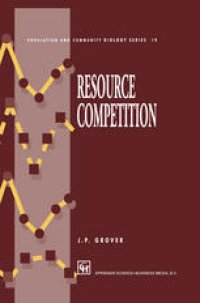
Ebook: Resource Competition
Author: James P. Grover (auth.)
- Tags: Evolutionary Biology, Ecology, Zoology
- Series: Population and Community Biology Series 19
- Year: 1997
- Publisher: Springer US
- Edition: 1
- Language: English
- pdf
As one of the most quantitative of ecological subdisciplines, resource competition is an important, central area of ecology. Recently research into this area has increased dramatically and resource competition models have become more complex. The characterisation of this phenomenon is therefore the aim of this book. ResourceCompetition seeks to identify the unifying principles emerging from experimental and theoretical approaches as well as the differences between organisms, illustrating that greater knowledge of resource competition will benefit human and environmental welfare. This book will serve as an indispensable guide to ecologists, evolutionary biologists and environmental managers, and all those interested in resource competition as an emerging discipline.
As one of the most quantitative of ecological subdisciplines, resource competition is an important, central area of ecology. Recently research into this area has increased dramatically and resource competition models have become more complex. The characterisation of this phenomenon is therefore the aim of this book. ResourceCompetition seeks to identify the unifying principles emerging from experimental and theoretical approaches as well as the differences between organisms, illustrating that greater knowledge of resource competition will benefit human and environmental welfare. This book will serve as an indispensable guide to ecologists, evolutionary biologists and environmental managers, and all those interested in resource competition as an emerging discipline.
As one of the most quantitative of ecological subdisciplines, resource competition is an important, central area of ecology. Recently research into this area has increased dramatically and resource competition models have become more complex. The characterisation of this phenomenon is therefore the aim of this book. ResourceCompetition seeks to identify the unifying principles emerging from experimental and theoretical approaches as well as the differences between organisms, illustrating that greater knowledge of resource competition will benefit human and environmental welfare. This book will serve as an indispensable guide to ecologists, evolutionary biologists and environmental managers, and all those interested in resource competition as an emerging discipline.
Content:
Front Matter....Pages i-x
Introduction....Pages 1-16
Theoretical and experimental foundations....Pages 17-47
Experimental studies of resource competition....Pages 48-88
Critiques....Pages 89-99
Nonequilibrium resource competition....Pages 100-131
Competition within food webs....Pages 132-171
Spatial heterogeneity....Pages 172-206
Competition for light....Pages 207-232
Resource competition and evolution....Pages 233-253
Applications....Pages 254-276
Conclusions....Pages 277-282
Back Matter....Pages 283-342
As one of the most quantitative of ecological subdisciplines, resource competition is an important, central area of ecology. Recently research into this area has increased dramatically and resource competition models have become more complex. The characterisation of this phenomenon is therefore the aim of this book. ResourceCompetition seeks to identify the unifying principles emerging from experimental and theoretical approaches as well as the differences between organisms, illustrating that greater knowledge of resource competition will benefit human and environmental welfare. This book will serve as an indispensable guide to ecologists, evolutionary biologists and environmental managers, and all those interested in resource competition as an emerging discipline.
Content:
Front Matter....Pages i-x
Introduction....Pages 1-16
Theoretical and experimental foundations....Pages 17-47
Experimental studies of resource competition....Pages 48-88
Critiques....Pages 89-99
Nonequilibrium resource competition....Pages 100-131
Competition within food webs....Pages 132-171
Spatial heterogeneity....Pages 172-206
Competition for light....Pages 207-232
Resource competition and evolution....Pages 233-253
Applications....Pages 254-276
Conclusions....Pages 277-282
Back Matter....Pages 283-342
....